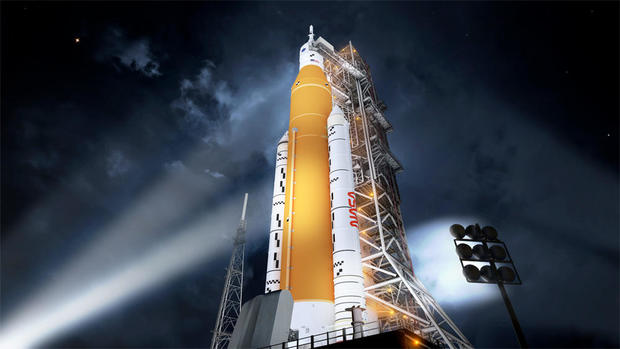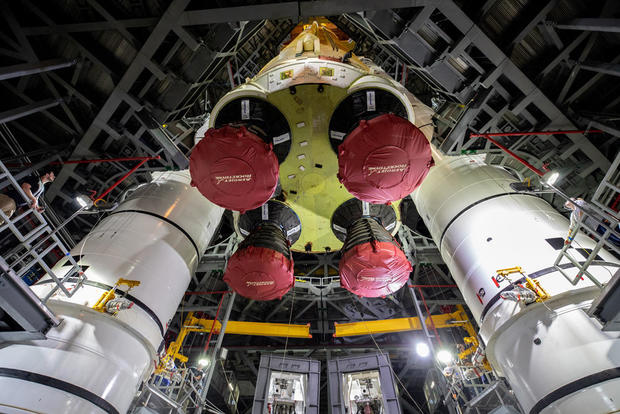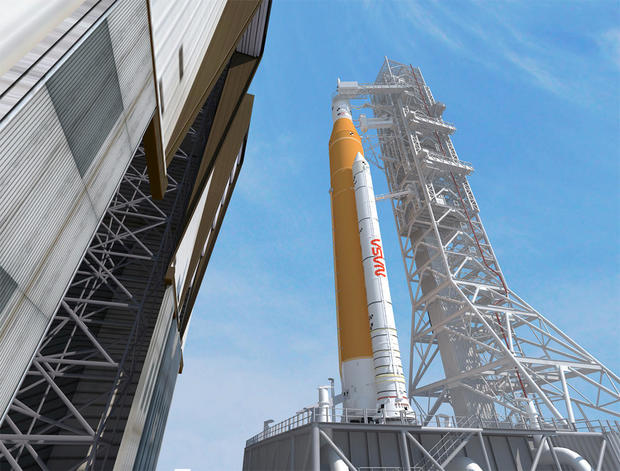Dress rehearsal for NASA's Artemis moon launch slips from February to March
A critical dress rehearsal countdown and fueling test of NASA's gargantuan new Space Launch System moon rocket is slipping from later this month to March to give engineers more time to complete final preparations, NASA officials said Wednesday. The delay means the rocket's maiden flight likely will slip into April if not later.
During a teleconference with reporters, Tom Whitmeyer, deputy chief of NASA's exploration directorate, declined to provide a specific target date for the SLS rocket's long-awaited first flight, saying engineers need to get through the "wet dress rehearsal" first.
"We really want to see the results of that test before we can ... predict with a good amount of confidence the period of time before we launch," he said.
Sources say rollout to pad 39B at the Kennedy Space Center for the wet dress rehearsal could come as early as March 8. But Whitmeyer would only say the two-week test is now targeted for March.
Because the SLS must be hauled back to Kennedy's Vehicle Assembly Building for post-test processing, launch on the Artemis 1 mission — a flight to send an upiloted Orion crew capsule beyond the moon and back — likely will slip to sometime during a period that opens April 8 and closes April 23. The next launch period after that runs from May 7 to May 21.
As for what prompted the delay to March for the wet dress rehearsal, Mike Bolger, manager of exploration ground systems at the Kennedy Space Center, said "there really isn't a significant thing that we're working on, it's just a volume of work and it's us being really meticulous and making sure that when we roll, we're ready."
He said the chairman of NASA's Aerospace Advisory Panel pointed out during a recent meeting that "if you miss your launch date and you have a successful launch, nobody's going to remember you missed your launch date. But if you hold your launch date and you have an unsuccessful launch, nobody's ever going to forget."
"I think that's exactly how we treat it," Bolger said. "We're finding that right balance of continuing to push to get this launched as soon as we're ready, but not before."
Running years behind schedule, Artemis 1 is the first flight for NASA's new moon rocket, a mission that will test the SLS booster and Orion capsule in flight before astronauts strap in for a piloted voyage around the moon in mid 2024.
The flight after that, Artemis 3, will carry the first woman and the first person of color to the moon in the 2025 timeframe. After rendezvousing with a SpaceX landing craft, the astronauts will descend to touchdown near the lunar south pole to become the first humans to walk on the moon since the final Apollo mission in 1972.
But first, NASA must carry out a complex series of tests to verify the performance of of the SLS, the Orion spacecraft and the ground systems required for servicing and launch.
The initial "block 1" version of SLS will be the most powerful rocket ever launched, standing 322 feet tall and tipping the scales at 5.75 million pounds when fully fueled. Its twin shuttle-heritage solid-propellant boosters and four upgraded space shuttle main engines will produce 8.8 million pounds of thrust at liftoff, 15% more than NASA's legendary Saturn 5 moon rocket.
The SLS is also one of the most expensive rockets ever built. NASA's Office of Inspector General reported last year that NASA will have spent nearly $30 billion on the SLS program through 2025. The first four Artemis moon flights are estimated to cost in the neighborhood of $4.1 billion each.
The block 1 SLS is made up of a giant 212-foot-tall Boeing-managed "core stage" with its four Aerojet Rocketdyne RS-25 main engines and a 45-foot-tall interim upper stage powered by a single Aerojet Rocketdyne RL10B engine.
Two five-segment Northrop Grumman solid rocket boosters, producing 3.6 million pounds of thrust each, are attached to the side of the core stage.
NASA has converted pad 39B for Artemis operations, tearing down a shuttle-era gantry and rotating service structure, erecting new lightning towers and beefing up a water deluge system designed to minimize heating and the acoustic shock of booster ignition.
A mobile launch platform used to carry shuttles to the pad has been converted for use with Artemis and now features a 355-foot-tall service gantry that will roll to the pad with the rocket, providing a crew access arm, power, data and propellant feeds through multiple rotating umbilicals and connections.
For the wet dress rehearsal, the first SLS will be hauled out to pad 39B for a full-scale practice countdown. The core stage alone will be loaded with 730,000 gallons of supercold liquid oxygen and hydrogen rocket fuel.
Flow rates, pressures and temperatures will be monitored throughout as the countdown ticks all the way down to the final 10 seconds, halting just before the main engines would ignite on launch day.
"When you think about wet dress, it's really getting the launch team together, running through a complete tanking of the vehicle, and then also a drain of the vehicle and doing it in the same environment, as we're going to have on launch day," Bolger said. "So it really is a full dress rehearsal for the team."
Once the two-day dress rehearsal is complete, the SLS will be hauled back to the Vehicle Assembly Building for inspections and work to address problems that might have turned up during the tanking test. The rocket then will be hauled back out to pad 39B to prepare it for launch.







